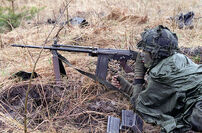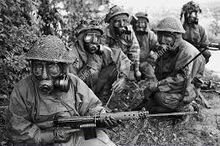The FN FAL (Fabrique Nationale Fusil Automatique Leger - National Factory, Light Automatic Rifle) Is a Cold War-era Battle Rifle that was originally designed and produced by the company Belgian Fabrique Nationale in Helstal. It remains one of the most produced Service rifles even today having over 2,000,000 rifles produced since it's Introduction in 1954, Being manufactured by Companies such as FN, IMBEL, and various others.
History[]
A Year after World War II had ended, In 1946, The Fabrique Nationale Company, after witnessing the Sturmgewehr 44's Success in the Wehrmacht, decided to set out in order to Develop a New Assault Rifle chambered in the Same 7.92x33mm 'Kurz' Cartridge as the Sturmgewehr. They Commissioned a Design team to develop this rifle and was led in it's efforts by Dieudonne Saive, Who had previously became famous for completing the development of the Browning Hi-Power Pistol under Fabrique Nationale. The First Prototype Rifle was Produced in 1948, and was subsequently Tested by the British Army. They Requested it be Chambered in .280 British (7.62x43mm), and in 1950, Both the FN FAL (T58), and British EM-2 Bullpup Rifle in .280 British were Tested by the U.S. Army as a Potential Service rifle to replace the M1 Garand. The U.S. Army were Impressed with the FAL, however, decided that the Cartridge was too underpowered at the time, and instead, Insisted that their T65 (7.62x51mm NATO) be adopted as Nato standard instead, as they believed that intermediate rifle cartridges would not be suitable for a service rifle. Acknowledging this, FN Redesigned their FAL Rifle for use with the 7.62x51mm T65 Cartridge, and by 1953, the First batch of FAL's chambered in 7.62mm were ready. The Rifle was Intended to become a standard rifle for Nato Countries, However, despite the T-58 FAL Rifle performing well in U.S. Army tests, The United States decided to adopt the T-44 Rifle as the M14 Rifle. The Rifle enjoyed Great Success with other NATO countries however, of which it became the main rifle of NATO, Earning it the Nickname 'Right Arm of the Free World'.

The Original FAL Prototype, .280 British
The Canadian Military were the First Country to adopt the FN FAL as their Service Rifle, as the C1A1 "Inch Pattern" Rifle, Modified from the Metric Pattern FAL Rifle, It featured a New Compensator, A folding Cocking Handle, A Semi-automatic Trigger Pack, and Various Welded rather than machined parts. This modified variant was also adopted by the British, and the Rest of the British Commonwealth in the following years, as the L1A1 Self-Loading Rifle (SLR), which had the option for a 4x Optic which were commonly used in the Commonwealth armies. An Automatic Support weapon variant also Developed in the L2A1/C2A1 Model, Which sported a Heavier Barrel, New Iron Sights, and an Integrated Bipod in the Handguard, as well as a new stock to help with recoil control. It Also featured a new 30 round magazine to assist in its newfound role as a support weapon. The Austrian Military Subsequently adopted the FAL as the Sturmgewehr 58, manufactured by Steyr, This variant was one of the first to use the Later Plastic Furniture kits. and was a More common 'Metric' type FAL, rather than the rarer 'Inch' Pattern FAL which primarily saw service with the British Commonwealth. West Germany Also Adopted the FAL in the Form of the G1 Rifle, However this was short-lived as Belgium refused to allow The Bundeswehr to produce the Rifle locally under License, and so the Bundeswehr Seeked to replace it with the G2 Rifle (Sig 510), which was also replaced subsequently by the Heckler & Koch G3 Rifle. The FAL Saw much more use in countries such as Turkey, Israel, Australia, South Africa, and Dozens of others, as it has seen service in over 90 Militaries.
Design[]

C2, the Canadian version of the FALO
The FAL is a Gas-Operated Weapon, that is driven by Short-stroke piston containing a spring, which is located above the barrel. and uses a Locking Mechanism, in which the action locks by dropping down into the receiver, similar to the SVT-40 Rifle action. A Controversial Design feature of the FAL is the Regulator behind the front sight that controls the gas system, to adjust the rate of fire, or chamber pressure for firing unsurpressed, or surpressed rounds, or to correct for environmental conditions. The System can fire Rifle grenades if a Blank Cartridge is loaded, by using the Gas plug to bypass the piston. For Rifles with a fixed stock, the Stock houses the recoil spring, whereas folding stock, or stockless rifles have to use a modified lower receiver to function without issue, although these are interchangeable, as well as a new bolt-carrier and recoil spring. The Regulator at the rear of the end sight, also reduced recoil by releasing pressured gas out of the fore-end, although in fully automatic the Rifle experiences severe recoil and barrel climb, due to it's heavy calibre. The system uses a locking bolt head locking tumbler with that slope back to the breech in the box that was made initially in steel wrought. But in 1973 began to test various types of metal fabrication in the breech of the box in order to reduce the production cost and weight, but manufacturing was attached to steel machined because of its tilting system that touches the case of breech.
Variants[]
Fabrique Nationale Variants[]

British Soldiers in NBC Gear (Nuclear, Biological and Chemical Defense Suits), With the L1A1 SLR Rifle
During the time the FAL was produced in several versions, however there are four basic configurations of the FAL :
- FAL 50.00,: Standard Infantry Rifle with Plastic Furniture
- FAL 50.63,/PARA-FAL: Infantry Rifle with Shortened Barrel, and Modified receiver to accommodate a Recoil spring with a folding stock; Designed for Paratroopers/CQC Fighting.
- FAL 50.64: 50.63, but with the standard Infantry Barrel.
- FAL 50.41 HBAR/FAP: Light Support Variant of the Rifle .
- FAL 50.42 (FALO): Identical to the FAL 50.41, but with wooden furniture
- G1 Rifle: Inch Pattern Rifles produced by FN, 100,000 ordered by use in 1956 for the Bundeswehr, and More ordered for the Bundesgrenzschutz (Border guards), Replaced by the G3 Rifle in Active Service, due to FN's refusal to grant a Production License to germany.
Foreign Variants[]

A British L1A1 SLR 7.62x51mm NATO
Inch Pattern Rifles[]
- L1A1/C1A1 Self-Loading Rifle: The British Commonwealth rifle, which saw service throughout the British, Canadian, Australian, New Zealand, and Rhodesian Armies, The first of the 'Inch' Pattern Rifles which Included a New compensator, and Cocking Handle, Semi-Automatic only. Inch Parts are not interchangeable with Metric parts.
- L2A1/C2A1 Support Weapon: Version of the L1A1, with a Heavier Barrel, Modified Handguard with Bipod, and Typically comes with a 30 round extended Magazine.
Metric Pattern Rifles[]
- IMBEL M2/M3/M4: Brazillian Modified Variants, that are Chambered in 5.56x45mm NATO rounds, Features a 7-lug Bolt-carrier group from an M16, as the FAL Bolt was found not to work very well with the lighter round. Uses STANAG Magazines for Feeding.
- DSArms SA58: American Commercial Variant of the FAL, Comes in both Standard and Modernized Configurations, Typically manufacture Metric Rifles.
Operators[]
- Angola
- Argentina: Produced under license.
- Australia: Produced under license.
- Austria: Produced under license.
- Bahrain
- Bangladesh
- Barbados
- Belgium
- Belize
- Bolivia
- Botswana
- Brazil: Produced under license.
- Burundi
- Cambodia
- Cameroon
- Canada: Produced under license.
- Chad
- Chile
- Colombia
- Congo
- Costa Rica
- Cyprus
- Democratic Republic of Congo
- Djibouti
- Dominican Republic
- Ecuador
- Fiji
- Gambia
- Ghana
- Greece: Adopted the FAL and FALO under license by the Pyrkal factories before using Hellenic Arms Industry-made G3A3s. This move was due to lack of support by the Greek government on Pyrkal. It was in use with the Greek special forces and the IV Army Corps in the Evros region from 1973 to 1999. The FAL was replaced in 2000.
- Guyana
- Honduras
- India: Produced under license.
- Ireland: Used as the main rifle of the Irish Defence Forces from the early 1960s (starting with UN service in the Congo) until 1988 when it was replaced. Its usual furniture consisted of a timber stock and black synthetic handguard and pistol grip.
- Israel: Produced under license.
- Jamaica
- Kenya
- Kuwait
- Lebanon
- Liberia
- Libya
- Luxembourg
- Malawi
- Malaysia
- Malta
- Mexico: Produced under license.
- Morocco
- Mozambique
- Myanmar
- Nepal
- Netherlands: The Royal Netherlands Army adopted the rifle with bipod and no fully-automatic capability in 1961, being called Het licht automatisch geweer, but usually known as the 'FAL' in Dutch service. They had unique sights (hooded at the front) and the German style sheet metal front handguard. A sniper version, Geweer Lange Afstand, also existed and was standard with a scope of Dutch origin produced by the Artillerie Inrichtingen and without the bipod. The scope was introduced as Kijker Richt Recht AI 62. The heavy-barrel FAL 50.42 version was also adopted later as a squad automatic weapon as the Het zwaar automatisch geweer. This rifle was replaced in the 1990s.
- New Zealand:
- Nigeria: Licensed by DICON (Defence Industries Corporation of Nigeria) in Nigeria as the NR-1.
- Oman
- Panama
- Papua New Guinea
- Paraguay
- Peru
- Portugal: In 1960, the Portuguese Army issued quantities of light-barrel FN and West German G1 FAL rifles to several of its elite commando forces, including the Companhias de Caçadores Especiais (Special Hunter [Ranger] companies). The latter often expressed a preference for the lighter FAL over the Portuguese-manufactured version of the H&K G3 rifle when on ambush or patrol. In Portuguese service, the FN FAL was designated Espingarda Automática 7,62 mm FN m/962.
- Rwanda
- Saint Vincent and the Grenadines
- South Africa: Produced under license. After a competition between the German HK G3 rifle, the Armalite AR-10, and the FN FAL, the South African Defence Force adopted three variants of the FAL: a rifle with the designation R1, a "lightweight" variant of the FN FAL 50.64 fabricated locally under the designation R2, and a model designed for police use not capable of automatic fire under the designation R3.

A West German soldier on a joint exercise with American troops in 1960. The Germans used the FAL briefly in the late 1950s and early 1960s under the designation Gewehr G1.
- Sri Lanka: The Sri Lankan Army adopted the L1A1 SLR rifle in the 1970s to replace the bolt action Lee Enfield rifle and Sten sub-machinegun. It was widely used in the early stages of the Sri Lankan Civil War before being replaced by the AK-47 and Type 56 assault rifles.
- Suriname
- Swaziland
- Syria
- Tanzania
- Thailand: Used by Royal Thai Police since the 1960s, designated "Rifle Type 05" (1962).
- Togo
- Trinidad and Tobago
- Tunisia
- Turkey: Used by the armed forces until the late 1960s, when it was replaced. However, the FAL remains in use as a training rifle.
- Uganda
- United Arab Emirates
- United Kingdom: Built under licence
- Uruguay
- Venezuela: Produced under license.
- West Germany
- Yemen
- Zambia
- Zimbabwe: In Limited Numbers

United States Marine with a British Enfield L1A1, during a training exercise as part of the Gulf War's Operation Desert Shield.
See also[]
References[]
The original article can be found at FN FAL and the edit history here.

